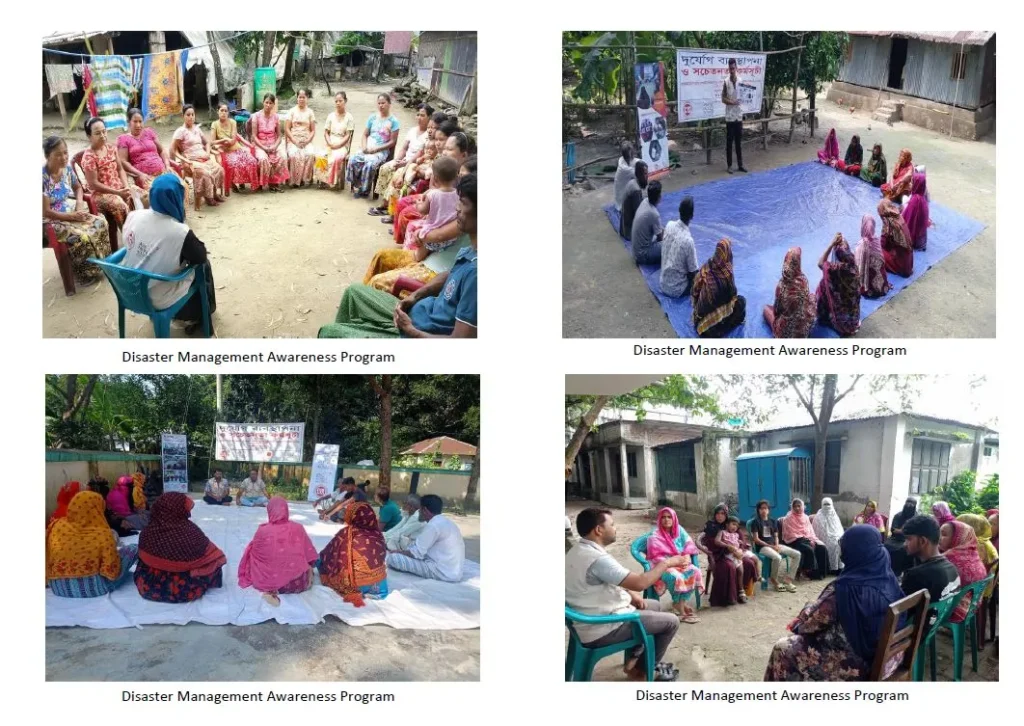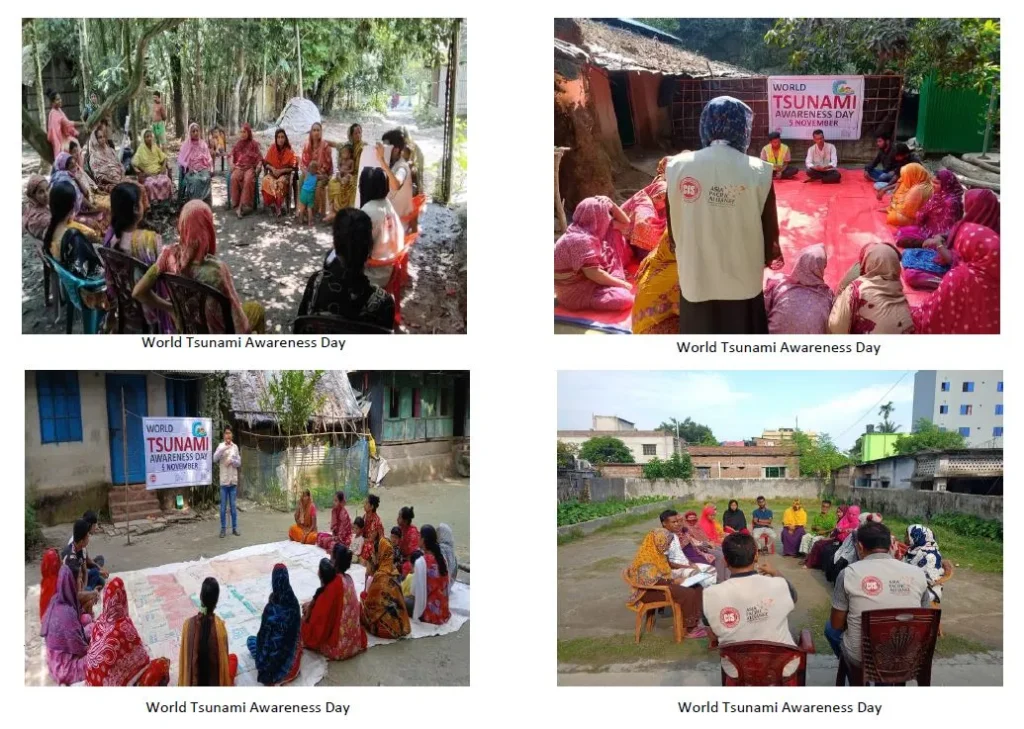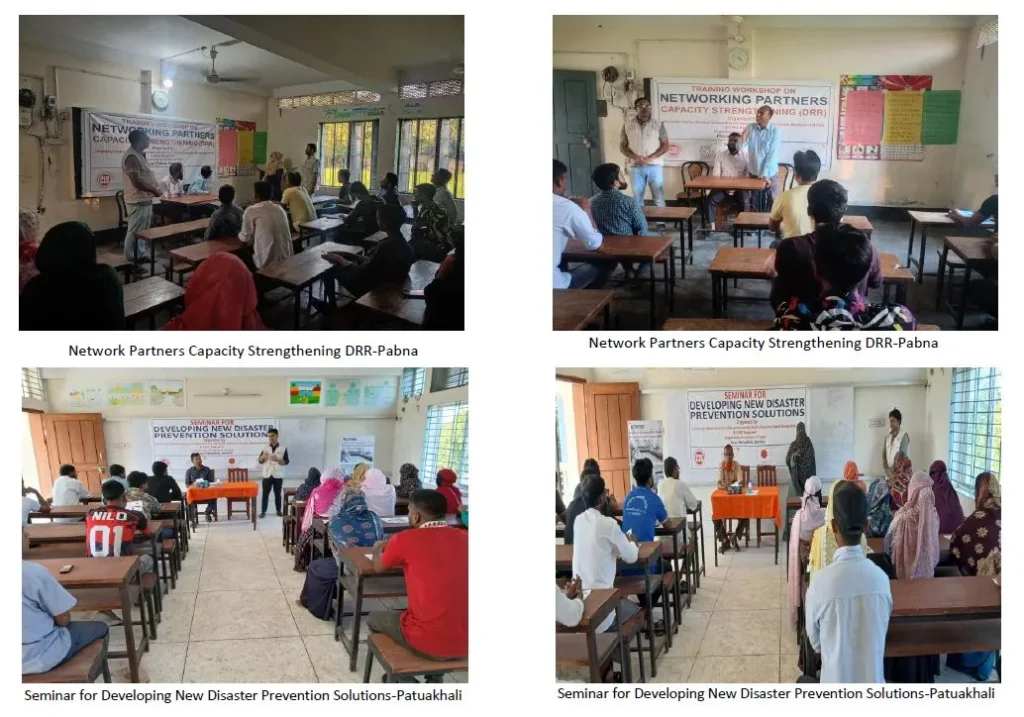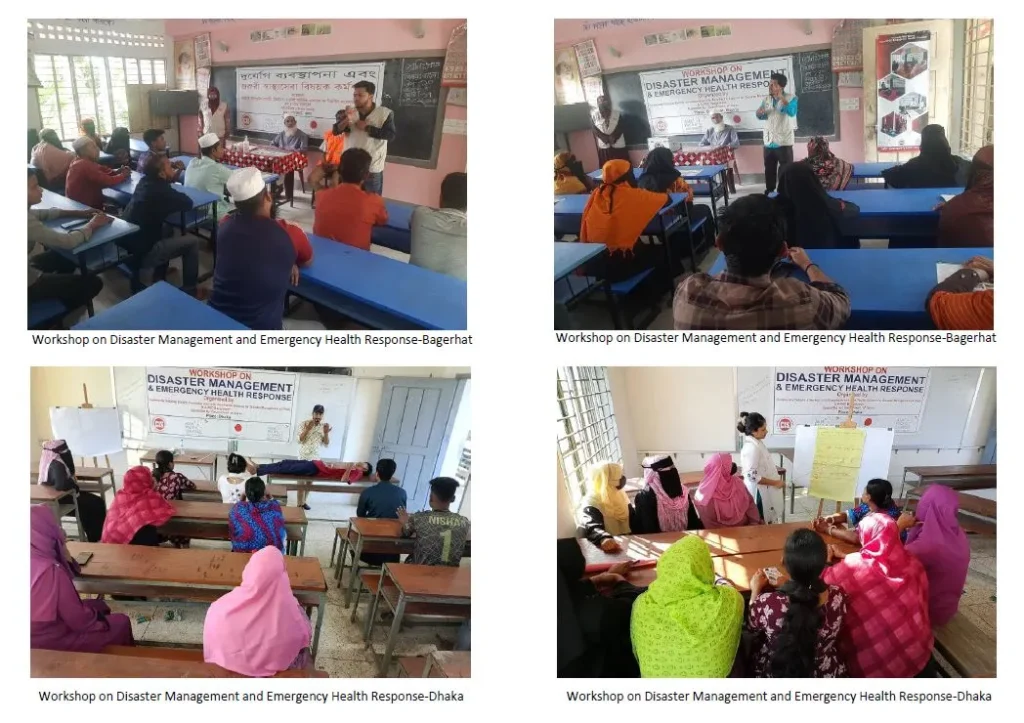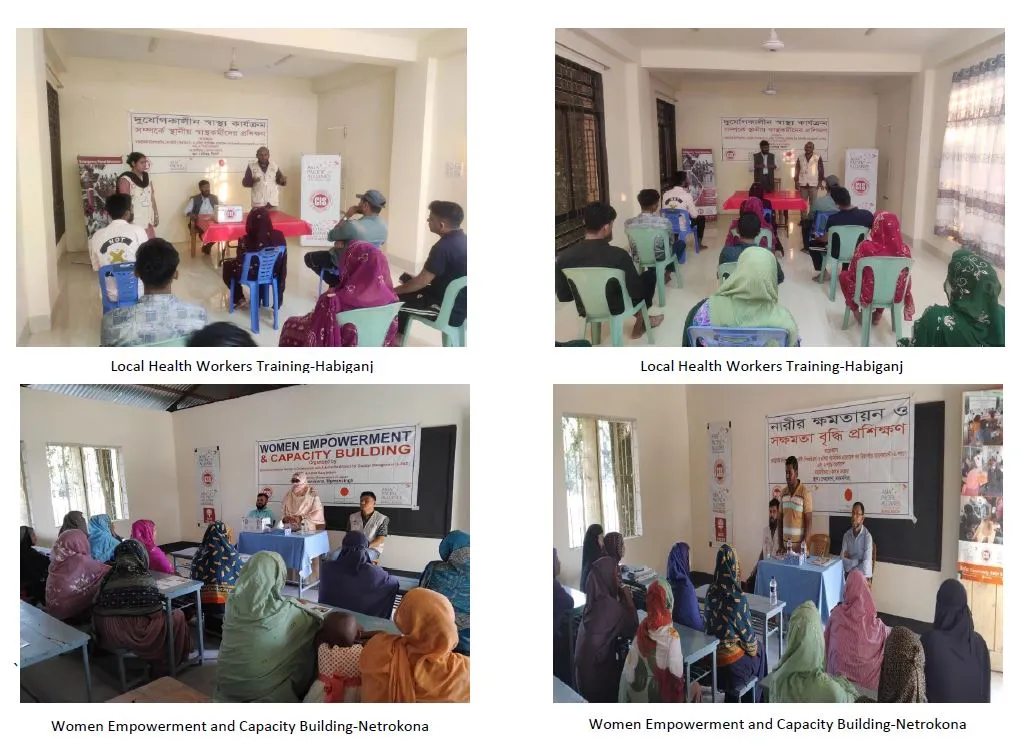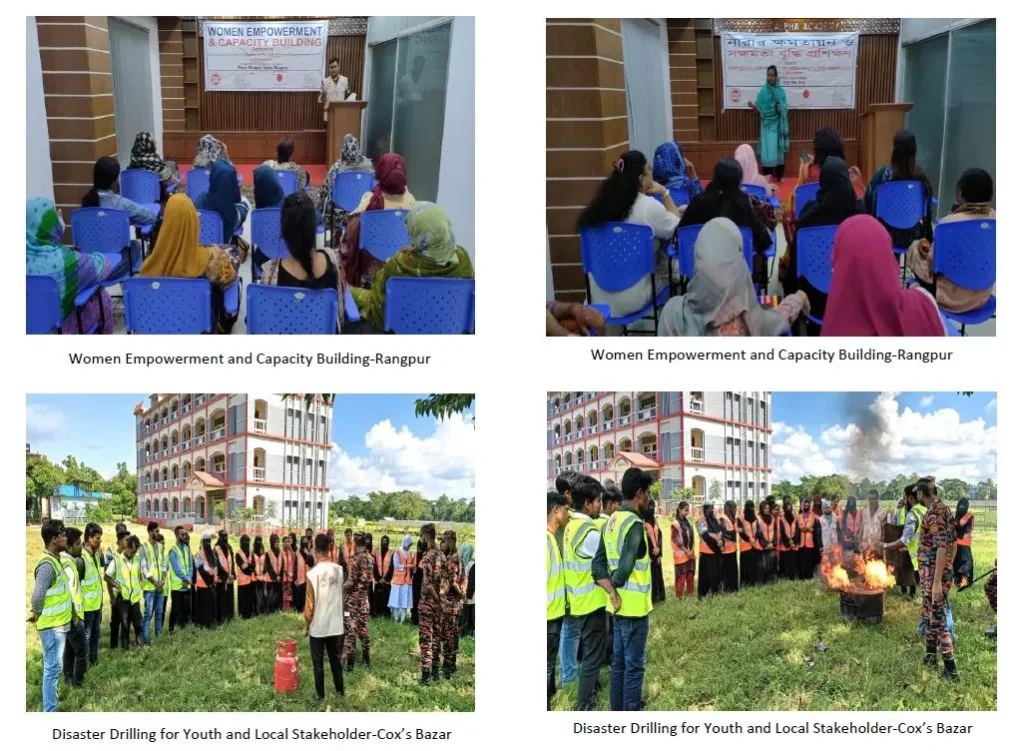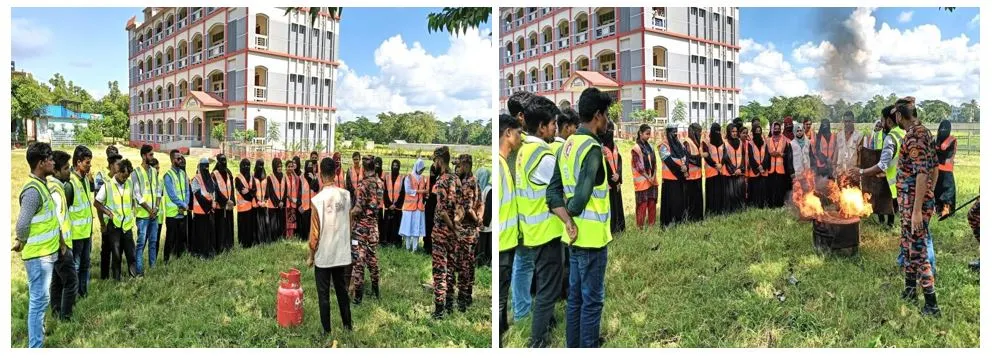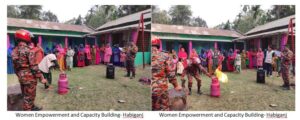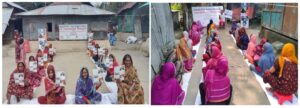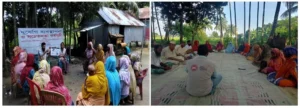Project Title: Strengthening Capacity for Sustainable Disaster Management Network by involving multi-sectoral platform Project Period: 17 January, 2024– 16 January, 2025 (12 month)
- Project Activities and Accomplishments
Bangladesh is ranking as one of the most disaster-prone countries. People in Bangladesh are often affected by water-related natural disasters, including floods, riverbank erosion and cyclones. In addition, recent rapid urbanization increases the risks for earthquake as well as man-made disasters. National Plan for Disaster Management (NPDM) 2021-2025 exemplified the strategic plan of the Government of Bangladesh in its Vision and the Mission of the Ministry of Disaster Management and Relief (MoDMR) between 2021 and 2025 towards building resilient nation. Bangladesh GOVT. has NPDM 2021-2025 has core goals for actions to save life, reduce economic losses in every disaster cycle stages which includes Disaster Risk Reduction (DRR), Humanitarian Response and Emergency Recovery Management. In Bangladesh most hazards impact: flood; cyclone and surge; tornado; earthquake; riverbank erosion; landslide; salinity intrusion; drought; tsunami; lightning; arsenic contamination; human-induced hazards and health hazards. The last hazard has potential for assuming significance because of the emerging risks in Bangladesh.
A-PAD Bangladesh started project from January 2023 and presently continue it 17 January 2024 to build up capacity on disaster management. It communicates with the different sectors like local community, community leaders, stakeholders, GOVT. officials continuing training on disaster management. To hold training program A-PAD Bangladesh staff organized small community meeting to sharing ideas on disaster and introduced them about A-PAD Bangladesh activity. A-PAD Bangladesh working 8 divisional areas.
There are 1 health workers in each divisions whose are doing home visit and aware the local community about basic disaster awareness. The health workers gave basic ideas about disaster management. A-PAD Bangladesh working at the rural areas. If there would be any directions or announcement from GOVT. or any disaster related news has been published the health workers delivered the message to the local community. Total 3,930 persons were benefited from A-PAD Bangladesh on November 2024.
A-PAD Bangladesh attended coordination meeting at the 8 divisions in Office of Deputy Commissioner. At that meeting different NGOs had joined and explained their activities. Besides this what will be the next activities of the GOVT. and NGOs were discussed at that meeting.
1. Strengthening of disaster risk reduction and disaster response system functions through the Emergency Disaster Management Coordination Center | ||
Activities | ( Outcome 1 ) The Emergency Disaster Management Coordination Center operated under this project will function as a disaster response base in each region, leading to the disaster risk reduction in the community and the strengthening of its disaster response system.: | Project Status: Achievements vs Outcome: If the activity is behind the schedule, please write the reason. |
1-1 Operation of Emergency Disaster Management Coordination Centers Target:Local communities 10 people×25 days×8 divisions×12 months =24,000 people | 【Indicators of Outcome】 1-1 The Emergency Disaster Management Coordination Center will be used for coordination meetings among partner organizations and relevant stakeholders during normal times, and will also serve as a center for health and public health guidance for the local residents. In the time of emergency, health services will be provided by emergency health workers. The Emergency Disaster Management Coordination Center will be used by 24,000 local residents (annual average) in the target area. (Indicator:number or visitors, record of services provided) 1-2 Through the Disaster Management Awareness Program, community residents will receive the latest disaster information and knowledge on how to respond to disasters, and people’s awareness of disaster prevention and response will be increased. (Indicator:Community disaster preparedness report) | Total 2,536 people visited to the Disaster Management Coordination Center to discuss about disaster preparedness and health related issues. Dhaka: 350 Persons Cox’s Bazar: 320 Persons Pabna: 316 Persons Bagerhat: 306 Persons Patuakhali: 311 Persons Habiganj: 308 Persons Rangpur: 315 Persons Netrokona: 310 Persons Total = 2,536 Persons |
1-2 Disaster Management Awareness Program Target:Local communities, Community leaders, Local NGOs, Private company workers, government officials 15 people × 8 divisions × 4 times ×12 months =5,760 people | A-PAD Bangladesh conducted Disaster Management Awareness programs at the 8 divisional areas where 514 persons have participated. Total 4 times training organized at each divisional areas. Dhaka:15 Participantsx 4 Sessons= 60+5=65 Participants Cox’s Bazar: 15 Participantsx 4 Sessons= 60+3=63 Participants Pabna: 15 Participantsx 4 Sessons= 60+2=62 Participants Bagerhat: 15 Participantsx 4 Sessons= 60+4=64 Participants Patuakhali: 15 Participantsx 4 Sessons= 60+5=65 Participants | |
|
| Habiganj: 15 Participantsx 4 Sessons= 60+6=66 Participants Rangpur: 15 Participantsx 4 Sessons= 60+5=65 Participants Netrokona: 15 Participants x 4 Sessons= 60+4=64 Participants |
2. Expansion of disaster management network to improve community vulnerability | ||
| (Outcome 2)The network of NPF will be expanded and the capacity of each region for disaster prevention and response will be strengthened. |
|
2-1 Network Partner Meeting Target : Local communities, Community leaders, Local NGO, Private Company Workers, Government officials 50 people × 5 villages × 8 divisions = 2,000 people | 【Indicator of Outcome】 2-1 Strategies, mechanisms, and action plans for disaster reduction cooperation are developed in each region through discussions at network partner meetings, and a framework for disaster reduction cooperation is established. (Indicator:Strategic Plan) 2-2 MOUs signed with at least 5 new organizations, including private companies, in A-PAD Bangladesh NPF to expand the network (Indicator:number of new MOUs signed) 2-4 Resources possessed by A-PAD BGD partner organizations are provided in emergency disaster response, and play the role of that organization in times of emergency. (Indicator:List of resources such as supplies, human resources and donations provided by partner organizations for emergency disaster response) |
|
2-2 Disaster Preparedness Campaigns Target:Partner organizations and local communities 50 people × 2 times × 8 divisions = 800 people | A-PAD Bangladesh organized World Tsunami Awareness Day on 05 November 2024. 05 November 2024, Dhaka, Total Participants 50 05 November 2024, Cox’s Bazar, Total Participants 50 05 November 2024, Pabna, Total Participants 50 05 November 2024, Bagerhat, Total Participants 50 05 November 2024, Patuakhali, Total Participants 50 05 November 2024, Habiganj, Total Participants 50 05 November 2024, Rangpur, Total Participants 50 05 November 2024, Netrokona, Total Participants 50 A rally was organized at designated points across various areas, where representatives from multiple organizations came together to participate. Following the rally, a seminar | |
|
| was held to facilitate discussions on disaster preparedness. During the seminar, experts and speakers presented valuable insights, sharing experiences and best practices. Participants actively engaged in conversations, which led to the formulation of a detailed action plan aimed at enhancing community resilience and preparedness for future disasters. This collaborative effort aimed to ensure that all organizations involved were aligned in their strategies and ready to implement effective measures. |
2-3 Network Partners Capacity Strengthening (DRR) Target : Partner organizations 20 people × 2 organizations × 2 times × 8 divisions = 640 people | A-PAD Bangladesh organized Network Partner Capacity Strengthening DRR at Pabna. 09-10 November 2024, Pabna, Total Participants 40+5= 45 Participants A-PAD Bangladesh conducted a training workshop focused on strengthening the capacity of network partners in Disaster Risk Reduction (DRR). The workshop aimed to enhance preparedness and build resilience within local communities during emergency situations. A total of 45 participants from various local organizations and community groups attended the event. During the workshop, the CIS presented its goals, mission, vision, and activities. It was emphasized on the first day that in Pabna, there is a need to focus on disaster response strategies for both earthquakes and fires, given that these events can abruptly transform a calm environment into chaos. |
|
| Building community resilience was also a key focus area, as robust communities possess a greater capacity to withstand the impacts of disasters. This can be achieved by fostering social cohesion, reinforcing local institutions, and empowering communities to engage actively in disaster risk reduction initiatives. In summary, the workshop underscored that effective disaster risk reduction requires a comprehensive approach that engages all segments of society—from individuals and communities to national and international organizations. By collaborating effectively, we can mitigate the impacts of disasters and cultivate more resilient communities. |
2-4 Seminar for Developing New Disaster Prevention Solutions Target : NGO, Disaster prevention related government organizations, Private sector personnels 30 people ( 2days ) × 8 divisions × 2 times = 480 people | The Disaster Prevention Solutions Seminar held in Patuakhali.
09-10 November 2024, Patuakhali, Total Participants 30+6= 36 Participants
In the field of Disaster Risk Reduction (DRR), numerous innovations have been implemented that have demonstrated their effectiveness and utility. To further advance these innovations, it is essential to identify the types that are most impactful in enhancing existing DRR capabilities. The Government of Bangladesh envisions a future where the risks posed to individuals, particularly among the poor and disadvantaged, from natural, environmental, and human-induced hazards are reduced to |
|
| manageable levels. Additionally, it aims to establish a robust emergency response system. Recently, a two-day seminar was conducted in Dhaka focused on developing new disaster prevention solutions. As one of the most disaster-prone cities globally, Patuakhali has accumulated significant experience in disaster risk management. However, it remains vulnerable to cyclones due to rapid urbanization and a limited number of open spaces for evacuation. These challenges, combined with the city’s high population density, considerably elevate the risk of injuries and fatalities, especially given the unpredictability of cyclone occurrences in Patuakhali.
Nevertheless, the implementation of disaster preparedness techniques is vital for saving lives and minimizing destruction within the city limits. Building resilience is a long-term endeavor that must be adapted to local contexts and embedded within national policies, strategies, and frameworks. This alignment is a critical prerequisite for achieving sustainable outcomes. |
2-5 International Symposium on DRR
Target : Government, Local government, private company, NOG, partner organization, representative of A-PAD | The Community Initiative Society (CIS) and the Asia Pacific Alliance for Disaster Management (A-PAD) are pleased to announce the collaborative organization of an International Symposium titled “Climate Change and Emergency Management Challenges for Asia Pacific: Towards a Disaster Resilient World.” This significant event is scheduled to take place on November 17, 2024, in Dhaka. |
member countries, etc. 200 people |
| The symposium aims to foster comprehensive participation and support from non-governmental organizations, private sector entities, business groups, and governmental representatives. By establishing a multi-sectoral platform within A-PAD Bangladesh, the symposium intends to enhance community resilience and improve the effectiveness of humanitarian responses at the national level. The overarching goal of the symposium is to increase access to resources and tools that promote inclusive planning, particularly for individuals with access and functional needs, as well as marginalized communities disproportionately affected by emergencies.
We are proud to share that a total of 214 participants attended the symposium, including representatives from A- PAD International and local platforms from member countries, government officials, universities, partner organizations, non-governmental organizations, school teachers, and local communities from the seven divisions: Dhaka, Rajshahi, Sylhet, Chattogram, Khulna, Rangpur, Barisal, and Mymensingh. |
3. Practical training to improve resilience of local communities | ||
| ( Outcome 3 ) Contribute to improving the disaster resilience of local communities through practical training. |
|
3-1 Disaster response capacity building of local community level in Health and | 【Indicator of Outcome】 3-1 a) Establish networks of community leaders who can lead disaster response and |
|
hygiene field | emergency health response in all districts of |
|
3-1 a) Workshop on Disaster Management and Emergency Health Response
Target : Local residents, Community leaders, Local NGO workers 25 people ( 2 days ) × 8 divisions × 2 times = 400 people | Bangladesh. (Indicator:Number and the List of community leaders for disaster response/emergency health in each 8 districts.)
b) Networks of human resources with the skills and know-how to respond to health emergencies will be established in all districts of Bangladesh to provide health services to the local residents in times of emergency. (Indicator:Data of NGO health personals who can respond in emergency. Number of residents who received the services in the cases of activities during emergency disaster in each 8 districts.)
3-2 a) Disaster preparedness training and drills will be documented in a manual, and women, youth groups, and local stakeholders who participate in the drills will be granted certificates of completion and work as disaster volunteer teams during actual disasters. (Indicator:Drilling Manual, Cases of activities in emergency disaster response) | A-PAD Bangladesh organized Workshop on Disaster Management and Emergency Health Response at Dhaka and Bagerhat. 11-12 November 2024, Bagerhat, Total Participants 25+4=29 Participants 27-28 November 2024, Dhaka, Total Participants 25+5=30 Participants
Disaster Risk Reduction (DRR) strategies are closely linked to the health sector, emphasizing the need for cohesive efforts in response and recovery. A recent two-day training workshop held in Dhaka and Bagerhat aimed to enhance capacities for disaster response and emergency health management during and after crises. The workshop attracted 59 participants from various sectors, including the local community, health sector representatives, local non- governmental organizations, and private entities.
The primary objective of the training was to ensure that participants were equipped to provide essential support and care for victims during emergencies, with a focus on saving lives. The discussions centered on prevalent disasters in Dhaka and Bagerhat, particularly the challenges posed by excessive heat and the rising incidence of dengue fever. Presently, hospitals are experiencing high patient volumes due to dengue, which has been declared a significant public health concern. |
| b) Disaster drills at junior high schools will be documented in a manual so that students who participate in the drills will have the skills to take appropriate action in the event of a disaster. (Indicator:Drilling Manual, Report of emergency disaster response) | The government reported that this outbreak represents the second-highest incidence of dengue fever in Dhaka. The workshop included critical discussions on preventive measures against the Aedes mosquitoes, as well as guidance on initial home treatments for dengue, given the current hospital capacity constraints. This collaborative approach aims to strengthen community resilience and improve health outcomes during emergencies. |
3-1 b) Training of Local Health Workers on Disaster Health Activities Target : Health workers who belong to local NGOs or civil organizations 20 people ( 3 days ) × 8 divisions = 160 people | 3 days training program organized in Netrokona where 30 participants joined in the training workshop. 12-14 November 2024, Habiganj, Total Participants 25+3=28 Participants Habiganj is one of the districts in Bangladesh, home to many community members. The primary goal of the training workshop was to enhance capacity for emergency health response during and after a disaster. A total of 28 participants from various organizations, including NGOs and private health workers at the union level from Habiganj, attended the workshop.The Capacity Building Initiative for Disaster Preparedness and Response in Bangladesh aims to strengthen the capabilities of these organizations to improve the resilience of communities in preparing for, responding to, and recovering from emergencies. The training program specifically focused on the disaster and health sectors, particularly in Habiganj, which is prone to various disasters, including cyclones, salinity, floods, and waterlogging. |
|
| During the workshop, discussions highlighted the activities that need to be considered during concurrent disasters, such as COVID-19. The training emphasized that all disasters are interconnected with health, and health providers, as frontline workers, are directly involved with the community and therefore face significant risks.Participants shared their feedback and practical experiences, while facilitators provided valuable technical knowledge to equip them to play a crucial role during future disasters. |
3-2 Strengthening disaster response capacities of local communities through disaster drilling training |
| |
3-2 a) Women Empowerment and Capacity Building
Target : Women’s groups in target villages 20 people ( 2 days ) × 8 divisions × 2 times = 320 people | A-PAD Bangladesh organized Women Empowerment and Capacity Building Drilling in Rangpur and Netrokona, where in total 48 participants joined. 11-12 November 2024, Rangpur, Total Participants= 20+3=23 Participants 13-14 November 2024, Netrokona, Total Participants= 20+5=25 Participants
Gender inequality, combined with the climate crisis, is one of the greatest challenges of our time. It threatens the livelihoods, health, safety, and security of women and girls around the world. Women tend to depend more on natural resources, yet they have less access to them. In many regions, women bear a disproportionate responsibility for securing food, water, and fuel. When disasters occur, women |
|
| are less likely to survive and more likely to be injured due to longstanding gender inequalities that have created disparities in information, mobility, decision-making, and access to resources and training. In the aftermath of such events, women and girls often struggle to access relief and assistance, further jeopardizing their livelihoods and well- being, creating a vicious cycle of vulnerability to future disasters. Climate change and disasters also endanger the health of women and girls by limiting access to services and healthcare, as well as increasing risks related to maternal and child health. Research indicates that extreme heat increases the incidence of stillbirth, and climate change is contributing to the spread of vector-borne illnesses such as malaria and dengue fever. The following benefits can arise from targeted training programs for women: 1. Increased Self-awareness and Confidence: Participants gain a deeper understanding of their own strengths, capabilities, and potential.
2. Improved Knowledge and Skills: The training equips participants with new knowledge, skills, and tools relevant to women’s empowerment and capacity building. This may include leadership skills, communication skills, problem-solving abilities, financial literacy, and entrepreneurship skills. |
|
| 3. Enhanced Decision-making and Critical Thinking: The training focuses on developing participants’ decision- making and critical thinking abilities, enabling them to analyze situations, assess options, and make informed decisions. 4. Strengthened Networking and Support Systems: Participants connect with like-minded individuals, creating a supportive network. 5. Increased Awareness of Women’s Rights and Gender Equality: The training emphasizes women’s rights, gender equality, and social justice issues, helping participants gain a deeper understanding of their rights and the importance of equality, as well as the impact of gender-based discrimination. 6. Community Engagement and Leadership: The training encourages participants to actively engage in their communities and take on leadership roles. |
3-2 b) Disaster Drilling for the Youth and Local Stakeholders Target:Youth in the local private and civic sector 45 people ( 2 days ) × 8 divisions × 2 times = 720 people | A-PAD Bangladesh organized drilling session in Rangpur total 50 participants joined.
06-07 November 2024, Cox’s Bazar, Total Participants 45+5= 50 Participants The coastal community of Bangladesh faces various natural disasters such as tropical cyclones, droughts, thunderstorms, and floods almost every year. These events often lead to significant damage to property and the environment in |
|
| coastal areas. Cyclones are among the most dangerous hazards. Community-Based Disaster Management (CBDM) is a practical approach that promotes the active involvement and participation of local communities in the planning, decision- making, and execution of disaster management activities.
Recently, CIS conducted a disaster drilling program in Cox’s Bazar for youth and local stakeholders. Youth play a crucial role in disaster preparedness and recovery; involving them in disaster planning increases their awareness of potential hazards in their neighborhoods and teaches them how to respond to different types of emergencies. The main objectives of a Search and Rescue team include:
1. Rescuing survivors trapped under the debris of damaged buildings. 2. Providing first aid services to trapped survivors and arranging for their medical care. 3. Taking immediate actions to support and protect endangered or collapsed structures. 4. Recovering and disposing of the bodies of the deceased. 5. Training and raising awareness on how to use local materials for community rescues. |
3-2 c) |
|
|
Disaster Drilling for Junior | ||
High Schools | ||
Target:School Children | ||
40 people ( 2 days ) × 8 | ||
divisions × 2 times = 640 | ||
people | ||
3-3 Update website | ||
contents as E-resources | ||
for Disaster | ||
Management | ||
| ||
| ||
| ||
| ||
| ||
| ||
| ||
| content/uploads/2024/12/IMG_7121.webp | |
| ||
| ||
| ||
| ||
| ||
| ||
| ||
| ||
| ||
|
- Challenges
Practice in collaboration with A-PAD Bangladesh Network Partners Please write good practice in collaboration with partner organizations
- Any contribution Funds Received and Grants Applied / Planned and Implemented Projects by CIS including Emergency Response
Please write Projects name and its fund resources
- Relationship with Bangladesh Government and Japanese Embassy Please write about Meeting with Government office
